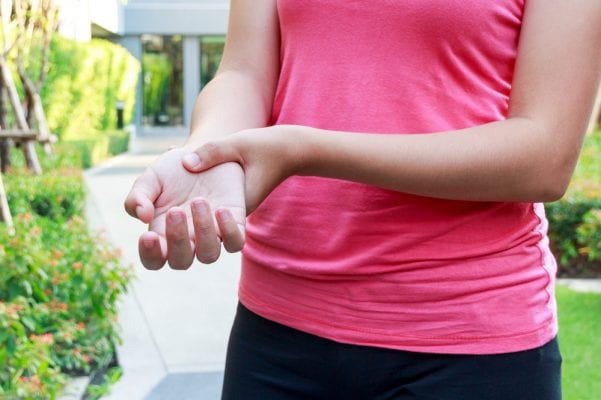
There are many different types of joint pain, including conditions involving just a single body part.
One example is de Quervain’s tenosynovitis, which affects the thumb and causes it to become inflamed, painful, and numb.1,2,3 The tendons at the base of the thumb become swollen with this condition, which creates pressure on the surrounding nerves. This makes it very painful to grab items, make a fist, or turn the wrist – all very common and necessary motions in daily life.
Here is a discussion of what De Quervain’s syndrome is, the tests to diagnose it, what triggers it, and how to find relief for this painful condition sometimes referred to as “mommy’s thumb.”
Causes and Triggers of “Mommy Thumb”
Repetitive use of the hands and the stresses of lifting objects often leads to the development of de Quervain syndrome. People whose jobs or hobbies involve repetitive hand motions are more likely to develop this condition. It is most common among women over the age of 40, in pregnant women, in people who have arthritis, and in people who have injured their wrist in the past.2,3,5
The condition is sometimes referred to as mommy’s thumb because it often triggered by traditional “mom tasks” like lifting children and bags of groceries. In new mothers, the condition commonly appears within six months of delivering a baby. However, anyone of any age can develop de Quervain’s syndrome.
De Quervain’s Syndrome Symptoms
The most common of all de Quervain’s syndrome symptoms is a pain at the base of the thumb.2 However, this pain may radiate up into the wrist and the forearm as well. In severe cases, individuals with this syndrome may notice a bulge on the thumb that is actually a cyst filled with fluid. The back of the thumb may feel numb, a squeaking sound may be heard when the tendons move, and a snapping sensation may be felt when the thumb moves.
The De Quervain Test/ The Finkelstein Test
A test called the Finkelstein test is usually conducted to determine if a patient has de Quervain syndrome.2,3 This test involves bending the thumb to rent on the palm, making a fist, closing the fingers over the thumb, and bending the wrist. Pain at the base of the thumb following this exercise may suggest the presence of de Quervain syndrome. This is because the motion of bending the wrist towards the outside of the hand causes swollen tendons to become stretched and strained.
The Eichhoff test is a modification of the Finkelstein test but is more likely to produce false positive results.4 X-rays are not typically needed to diagnose this condition, and primary care doctors and usually make this diagnosis fairly easily.
Finding Relief for De Quervain’s
It is best to avoid activities that involve repetitive hand and wrist motions to relieve de Quervain pain.6 Doctors often recommend nonsteroidal anti-inflammatory drugs, arthritis pain relief creams like JointFlex, applying heat or ice, and wearing a splint to stabilize and rest the thumb. Wearing a splint for 24 hours a day is typically recommended for this condition. 6
In severe cases, it may be necessary to discuss injecting anesthetics or steroids into the tendon to reduce pain and swelling.1 The recovery time varies greatly based on whether the disorder has developed suddenly or gradually, the age of the patient, and how long the symptoms have existed.
REFERENCES FOR UNDERSTANDING DE QUERVAIN SYNDROME AND WHAT CAUSES IT
1. Steinberg, D. R. (2018 August). De Quervain syndrome. Merck Manual: Consumer Version. Retrieved November 1, 2018 from https://www.merckmanuals.com/home/bone,-joint,-and-muscle-disorders/hand-disorders/de-quervain-syndrome.
2. De Quervain’s tendinosis. American Academy of Orthopaedic Surgeons. Retrieved November 1, 2018 from https://orthoinfo.aaos.org/en/diseases–conditions/de-quervains-tendinosis/.
3. Starecki, M. J. (2017 October 17). De Quervain’s tenosynovitis. Sports Health. Retrieved November 1, 2018 from https://www.sports-health.com/sports-injuries/hand-and-wrist-injuries/de-quervains-tenosynovitis.
4. Wu, F., Rajpura, A., & Sandher, D. (2018 August). Finkelstein’s test is superior to Eichhoff’s test in the investigation of de Quervain’s disease. Journal of Hand and Microsurgery, 10, 116-118. DOI: 10.1055/s-0038-1626690. Retrieved November 1, 2018 from National Center for Biotechnology Information https://www.ncbi.nlm.nih.gov/pubmed/30154628.
5. De Quervain’s disease. Genetic and Rare Diseases Information Center. Retrieved November 1, 2018 from https://rarediseases.info.nih.gov/diseases/9413/de-quervains-disease.
6. Starecki, M. J. (2017 October 17). Nonsurgical treatment for De Quervain’s tenosynovitis. Sports Health. Retrieved November 1, 2018 from https://www.sports-health.com/sports-injuries/hand-and-wrist-injuries/nonsurgical-treatment-de-quervains-tenosynovitis.
